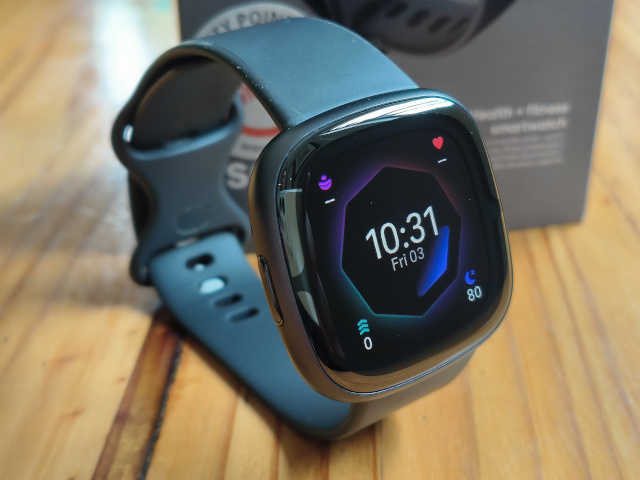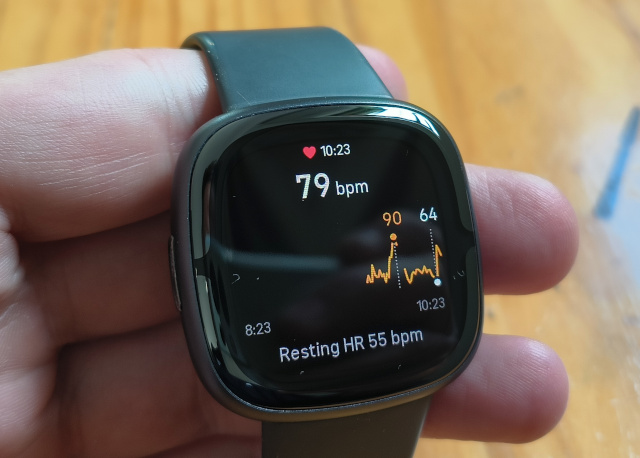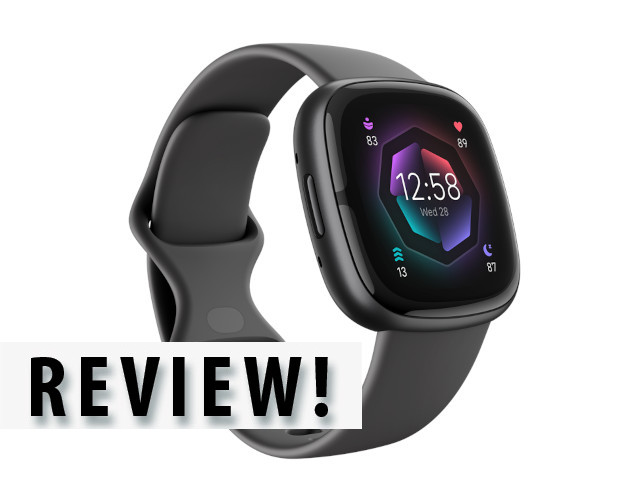Fitbit’s Sense 2 picks things up where the original Sense left off. Overall, the Sense 2 is a much improved device with a few noteable extras, and a couple of let-downs.
First the good stuff, and this time round even though the design of the watch looks pretty much the same, it works a lot better with the physical button incorporated on the left-hand side. It’s MUCH better than the previous touch button which often did not quite ‘press’ as intended.
Fitbit also managed to improve the user interface on the Sense 2, with information flowing a lot better. Scrolling through the screens provides most of the information you need in a clearer fashion, while you can also swipe up to see your notifications, and down for further options with the watch’s setup.
Look carefully and you’ll see a border of sorts round the edges of the watch, which is there to accommodate on-the-spot EDA scans. It adds a silver tint around the frame (from certain angles it looks like a bit of plastic that did not peel off), but it’s not always noticeable and far from a concern.

It’s the sensors that count
So why get the Sense 2 rather than the less expensive Versa 4? The Sense 2 can be seen as Fitbit’s flagship (apart from the Google Watch, not available in SA), and although the Sense 2 and Versa 4 look pretty much the same (there are a few more colour options on the Versa 4), you do get a more health sensors, including a cEDCA sensor, the EDA scan, and an ECG app and a skin temperature sensor.
For this reason, the Sense 2 is pitched to those more interested in a more holistic approach to health monitoring, even though it comes with a few caveats. For example, the skin temperature sensor only tracks your body heat during night, with no way to access your temperature during the day or a workout session for example.
The EDA (Electrodermal Activity) sensor, used by pressing your hand on the borders of the watch, is the most immediately interesting feature. By initialising this through an app on the watch and placing your hand on the Sense 2, it tracks your responses on your skin and from your heart for two minutes to give an overall impression of your current stress level. This is logged by Fitbit as a “mindfulness session”, even though it's perhaps not intended as such by the user. You only get to do a two minute quick scan, and for longer ones you have to revert to the app for a guided mindfulness video. It would have been great if the EDA scan could have monitored longer sessions on its own, for example during quiet meditation.
After the session you can log how you feel, check the amount of EDA responses, your heart rate beginning and end, with the feature also noting your heart rate variability.
The cEDA sensor on the other hand monitors your body throughout the day, there to basically check your stress levels. You will receive a notification on your watch if it detects a certain amount of stress, which notifies you of the state, ask you to log how you are feeling, plus offer options to help with stress relief. In the app you are able to view your daily body responses and how long they last. Your overall Stress Management score, which also incorporates aspects such as sleep and tiredness, cannot be obtained unless you are a premium subscriber. Overall, the stress management feature will work better for those looking to put a bit of effort into it. While I appreciated the notifications, they of course came at rather stressful periods of work, which allows less time to track how you are feeling in the moment, or do a mediation.
Finally the ECG app, which checks for atrial fibrillation (AFib). This is not done automatically, rather through a 30 second process where you put your thumb and forefinger on the corner of the watch. It’s a good addition, although perhaps less crucial if you do not have any known heart problems. The Versa 2 will also notify you about high or low heart rates if detected after 10 minutes of inactivity.

And more
The Fitbit Sense 2 can, of course, also be used to track your activities, with Fitbit known for its great sleep monitoring. If you’ve started running or walking, the Sense 2 uses GPS to track your distance and route, and can display a number of metrics on the watch face. It’s not a watch meant for those taking their running regime too seriously, for this it’s best to look at a Garmin perhaps. In comparing it to my regular smartwatch, the Garmin Forerunner 245, the Sense 2 often showed a shorter track distance, with the GPS less accurate.
You can also receive calls on your wrist thanks to a speaker on the unit. This works fine if you are in a low noise environment, otherwise it’s a bit difficult to hear. While Amazon Alexa voice control makes an appearance, Google Assistant is not up and running yet, surprising since Google owns Fitbit. If you were used to controlling Spotify through your Fitbit, the Sense 2 puts an end to that, while also ending a host of third-party apps. It’s a shame, but truth be told, I rarely used them anyways. If it’s apps you’re after, however, the Apple Watch remains the gold standard.
Google Wallet can be used as a tap-and-go payment option on the Versa 2, while Google Maps can now give directions on the watch (driving, walking and cycling) once activated.
The Sense 2 offers up to five days’ worth of battery life, perhaps a day or so less/more depending on how much you use the GPS or if the always-on display is selected.
For you?
The Fitbit Sense 2 is aimed at holistic, health-conscious users, especially with added sensors such as an cEDA sensor to monitor all day stress and the ECG app to detect atrial fibrillation.
While the redesigned user interface and added physical button truly improve the overall experience, users will unfortunately only be able to get the most out of the Sense 2 if also subscribed to Fitbit’s premium service. This unlocks, amongst others, your daily readiness score, stress score, health reports and 30-day trends on heart metrics. You do receive a solid six-months Premium for free, thereafter it’s a rather expensive R190 per month, or R1 550 for the year.
If you are concerned about your heart and stress levels, the Versa Sense 2 becomes a more sensible buy. However, if you’re not concerned with these, the less expensive Versa 4 might be a more prudent purchase.
At R7 500, the Fitbit Sense 2 is the most expensive in the Fitbit line-up, but also the most feature rich (not counting the Google Watch, not available in SA). If you do need the ECG app but at a lower price, the Fitbit Charge 5 offers it, while also able to do EDA scans. The Charge 5 can be had for a more affordable R3k.
DISCLOSURE: The Fitbit Sense 2 was received as a test unit from Fitbit and not returned.




